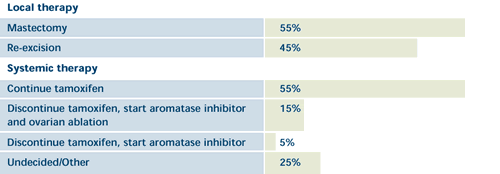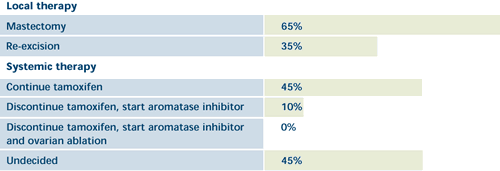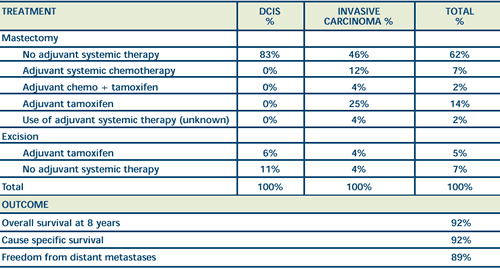|

What is the optimal local and systemic therapy
of local recurrence in the breast?
 |
|
OVERVIEW:
Approximately 80-90% of breast cancer local recurrences
appear within five years after mastectomy. One-fourth
to one-third of patients with local or regional recurrence
have had preceding distant metastases. Another one-fourth
of patients are diagnosed as having simultaneous local
and distant failure or develop distant metastases within
a few months of the local recurrence. The management
of these patients continues to evolve and a gold standard
for treatment is controversial. Should patients who
initially had breast conserving surgery now have a mastectomy,
or is re-excision appropriate? What is the role of radiotherapy
and chemotherapy? Should tamoxifen be discontinued and
should the patient be started on an aromatase inhibitor
and/or ovarian ablation? The answer to these questions
are determined according to thoughtful consideration
of the clinical and pathological characteristics of
the patient at the time of recurrence.
|
|
 |
 |
| |
A woman is diagnosed by mammogram with an upper,
outer quadrant lesion that is excised and proven to be a 0.8 cm
noncomedo DCIS. The margins are clear to 1 cm. She is treated with
radiation therapy and tamoxifen. Years later, she presents with
a nodule in the suture line, which is excised and found to be recurrent
DCIS.
|
Which of the following therapies would you be most likely
to recommend if she were 43-years-old?

|
|
Which of the following therapies would you be most likely
to recommend if she were 65-years-old?

|
|
Which of the following therapies would you be most likely
to recommend if she were 78-years-old?

|
SURGERY FOR LOCAL RECURRENCE
Although salvage mastectomy is currently the standard surgical
treatment for IBTR [ipsalateral breast tumor recurrence], a small
series has shown that breast conservation plus salvage radiotherapy
to the operative area is well tolerated and results in reasonable
long-term local control of the disease. This strategy needs to be
further explored and eventually compared directly with salvage mastectomy.
—Mamounas E P. Clin Oncol
2001;19(18):3798-3800.
Abstract
CHEMOTHERAPY FOR LOCAL RECURRENCE
Although there are few retrospective studies to address the care
of patients with local-regional recurrent nonmetastatic breast cancer,
treatment consisting of complete surgical excision, comprehensive
irradiation, and systemic therapy is now considered the standard
of care by many. The role of chemotherapy is perhaps the most controversial
aspect of treating local-regional recurrence after mastectomy.
—Ballo M et al. Int J Radiat
Oncol Biol Phys 1999;44(1):105-112.
Abstract
Local recurrences occur most frequently in the skin, and the optimal
treatment consists of complete excision of gross disease followed
by irradiation. This approach has improved local control and survival
in most series. For systemic management, antihormonal therapy should
be administered concurrently with irradiation to all receptor-positive
patients. Chemotherapy, using a combined or sequential application
of Adriamycin and Taxol, has become a standard treatment in advanced
breast cancer, but it may be ineffective in resolving local recurrence.
—Harms W et al. Int J Radiat
Oncol Biol Phys 2001;
49(1):205-10. Abstract
INNOVATIVE RADIOTHERAPIES FOR LOCALLY RECURRENT
BREAST CANCERS
PDR (Pulsed-Dose-Rate)Brachytherapy
Even applying the most appropriate treatment, local failure rates
up to 52% have been reported after treatment of local recurrences.
Treatment options in this situation are limited, and, due to an
increased normal tissue complication probability, reirradiation
is used with caution. On the other hand, 62% of the patients with
uncontrolled locoregional recurrences experience severe clinical
problems and an extremely impaired quality of life. As an alternative
to reirradiation with electrons...PDR (pulsed-dose-rate) brachytherapy
molds for breast cancer local recurrences is effective and provides
a high local control rate with acceptable toxicity.
—Harms W et al. Int J Radiat
Oncol Biol Phys 2001;
49(1):205-10. Abstract
HYPERFRACTIONATED, ACCELERATED RADIOTHERAPY
(HART)
The need for radiation therapy after surgical excision is well
supported by the literature, but optimal dose, treatment volume
and schedule are often debated... Hyperfractionated, accelerated
radiotherapy (HART) has been advocated for patients with local-regionally
recurrent breast cancer because it is believed to enhance treatment
effects in rapidly proliferating or chemoresistant tumors. It allows
delivery of intense radiotherapy in a shortened time period, reducing
the patient’s hospital visits and hastening the delivery of
additional chemotherapy. In our study, we found that no obvious
advantage was shown for HART and the reduction of overall treatment
time seemed unable to improve the local-regional control achieved
when the equivalent dose of conventionally fractionated radiotherapy
was used. Our current strategies to improve on these outcomes include
dose escalation and concurrent chemoradiotherapy for this patient
population.
—Ballo M et al. Int. J. Radiat
Oncol Biol Phys 1999;
44(1):105-112. Abstract
 |
| SERIES OF 43 DCIS PATIENTS WITH LOCAL
RECURRENCE |
|
| Salvage Treatment for Local Recurrence after
Breast-Conserving Surgery and Radiation as Initial Treatment
for Mammographically Detected DCIS of the Breast (n=43) |
 |
 |
“In summary, the current study has demonstrated that local
recurrences after the initial treatment of mammographically detected
DCIS using breast-conserving surgery and definitive breast irradiation
can be salvaged with high rates of overall survival, cause specific
survival, and freedom from distant metastases. Favorable prognostic
factors after salvage treatment were intraductal carcinoma as the
histology of the local recurrence and mammography only as the method
of detection of the local recurrence. As local recurrences are generally
salvageable with further treatment, prolonged and careful follow-up
after the initial management of DCIS with breast-conserving surgery
and definitive breast irradiation is warranted.”
—Solin LJ et al. Cancer 2001;91(6):1090-97.
Abstract
 |
| MILAN SERIES OF 191 LOCAL RECURRENCE CASES
AFTER BREAST CONSERVING SURGERY FOR EARLY BREAST CANCER |
|
| |
 |
 |
—Derived from Salvadori B
et al. Brit J of Surg 1999;86(1):84-7.
“Since the two surgical options were not randomized, no statistically
reliable comparison could be obtained. Furthermore, the favourable
results after re-excision could simply reflect patient selection.
However, total mastectomy does not seem to prevent patients from
developing distant metastases. In conclusion, half the patients
were disease-free five years after reoperation. Re-excision was
not disadvantageous in selected patients. Selection should include
small solitary recurrences in a breast large enough to permit a
satisfactory cosmetic result. The patient should be consented appropriately
about the risk of a further IBTR.”
—Salvadori B et al. Brit
J of Surg 1999;86(1):84-7.
View References
Back | Top of Page

|



